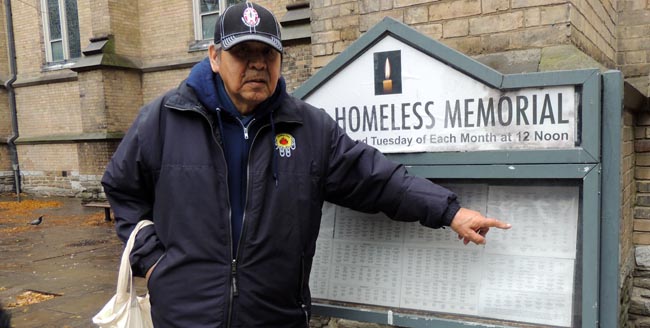School survivors died on city streets

By Christine Smith (McFarlane)
TORONTO – Tucked away where no one can really see it in the heart of Canada’s largest city is a weather-beaten memorial with 697 names listed on it. The names on the plaque include those of nine survivors of the same residential school attended by Elder Andrew Wesley.
“It is an honor to be standing here at this historic event” Wesley told participants at a Truth and Reconciliation gathering Nov. 12 at City Hall. “There’s a little church behind the Eaton Centre, and outside that church there is a memorial, and that memorial has the names of our brothers and sisters who have died on our streets.
“Though the Toronto Homeless Memorial is not specifically for residential school survivors. It is for the homeless people who have died on the street. Nine of the people listed are survivors of the same residential school I went to,” says Wesley, who went to St. Anne’s Residential School in Fort Albany for 11 years.
During the event, the City of Toronto along with the Truth and Reconciliation Commission of Canada (TRC) proclaimed Nov. 12, 2013 to Nov. 12, 2014, the Year of Truth and Reconciliation in Toronto to acknowledge the impact of the Residential School System on Aboriginal peoples and on all Canadians.
“For me,” said Wesley, “it’s a great event for them to wake up their spirit so that Toronto acknowledges that ‘it’s not their fault that they ended up on this memorial because something happened when they were in school. It’s a great event for me especially to honour them and to also see some survivors here in this room.”
Speakers included Councillor Mike Layton, TRC Chair Justice Murray Sinclair, and Phil Fontaine, former National Chief of the Assembly of First Nations, who was the Honorary Witness for the event. Students from Hagersville High School presented artwork to the Truth and Reconciliation Commission and the City of Toronto that was produced in a project called “Walking Together Intergenerational Community Arts Project” with the Woodland Cultural Centre.
One of the students, Holly La Forme, said “The stories of residential school weren’t anything new, but having the experience of reliving it with former students made it real.”


